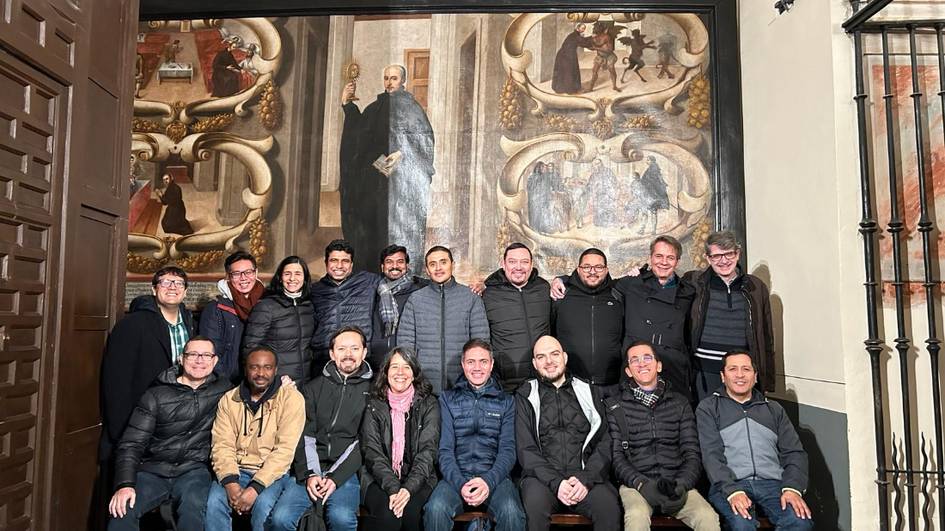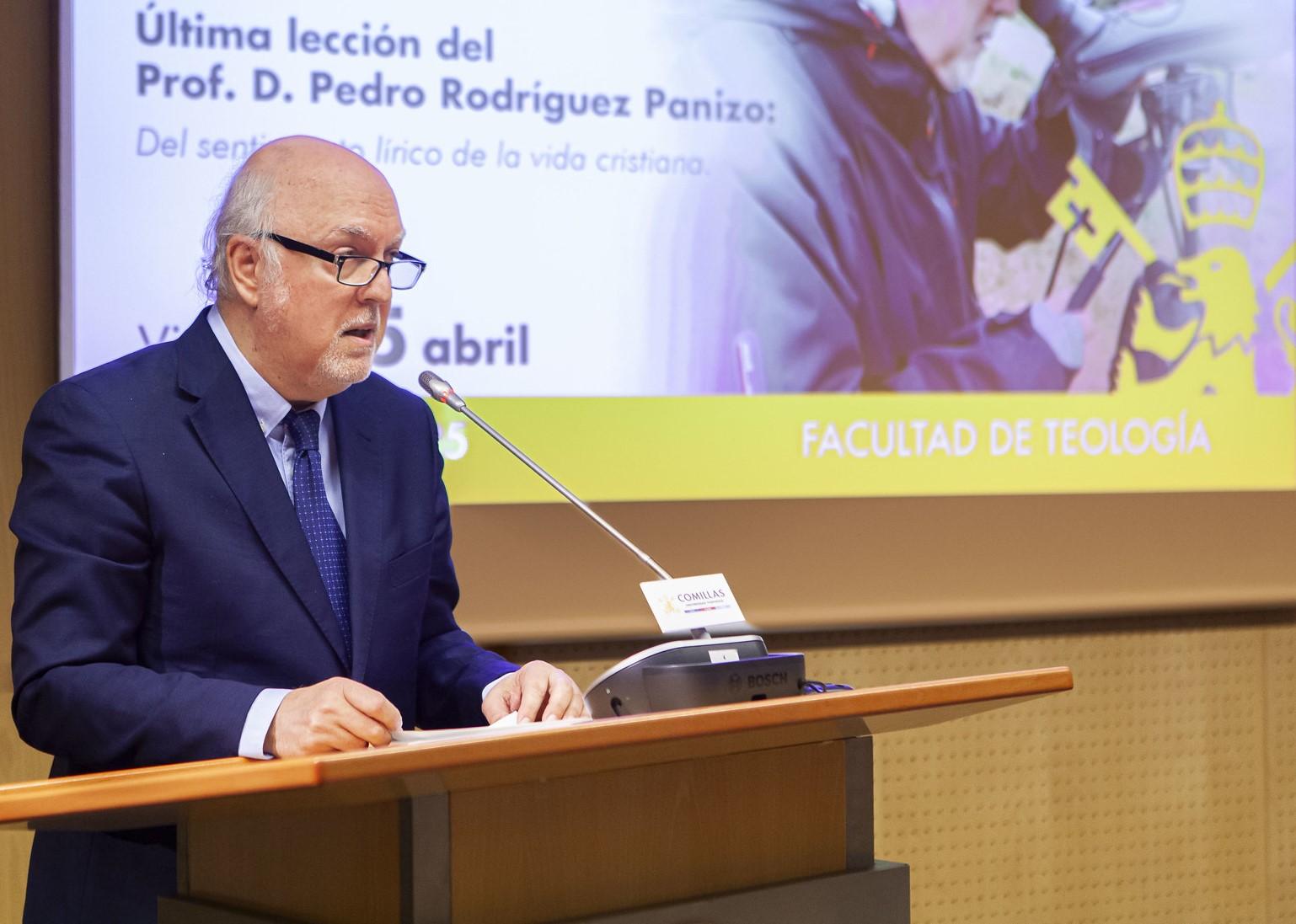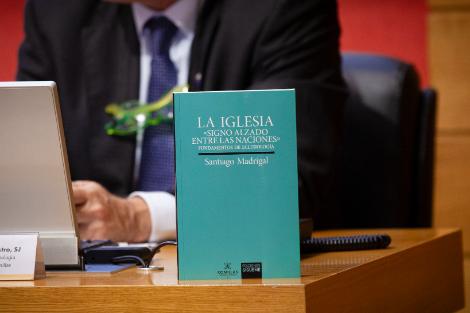Visit of the Ignatiana Master to Alcalá de Henares
A total of 17 students from the Master's programme and Javier Cía, SJ, PhD, as a guiding Professor, visited the 'Ignatian Alcalá'. José Antonio Lama, SJ, tells us about it in this chronicle

Students of the Master's Degree in Ignatian Spirituality with Prof. Javier Cía, SJ, PhD
26 February 2024
The Master in Ignatian Spirituality (Master Ignatiana) is an interdisciplinary programme that harmoniously handles History, Anthropology, Theology and spirituality studies as complementary perspectives for an integrated understanding of the Ignatian charism. As part of the training programme, a visit to Alcalá de Henares, discovering the footsteps of St. Ignatius of Loyola, took place on February 9th with Professor Javier Cía, SJ, PhD, as guide. Professor Javier Cía Blasco, from the Department of Moral Theology and Praxis of Christian Life, is PhD in Theology and an expert in Ignatian spirituality.
The following is the chronicle of the visit of José Antonio Lama, SJ:
Alcalá welcomed us with rain, blessing or bad luck? It depends on how you look at it. We met last Friday 9 February at 10 am at the door of the train station, walked a few metres along Pedro Laínez street to the Plaza del 11 de Marzo, where there is a statue in homage to those who died in the 11M bombings. This story was the starting point of our inner pilgrimage. Metallic men, women and children stood upright to avoid the fading of memory. There we began our reading of Ignatius' arrival in Alcalá in 1526 from Barcelona with the aim of training in theology and philosophy.
We head for the hospital of Nuestra Señora de la Misericordia or Antezana, known as the little hospital, where Ignatius spent almost a year. On the way, we came across the open church of the Company and the old college. We contemplate the façade, by the way, very similar to that of the Church of the Gesù in Rome and now supporting the nest of at least five storks. We went inside to greet our saints and see the temple, or at least the way it was reinvented after the looting of the civil war. Ten minutes later we were already in the hospitalillo, where a very friendly girl welcomed us and offered to answer any questions we had in four different languages, surely in response to the multicultural nature of our group.
Ignacio moved to the 'hospitalillo' shortly after arriving in Alcalá. This space provided help to the sick and also functioned as a hostel-shelter for pilgrims. The courtyard of popular architecture in the Mudejar tradition is in good condition and houses a small museum that narrates the history of the place and preserves a manuscript of Cardinal Cisneros, founder of the University of Alcalá, which undoubtedly caught our attention. After a short tour of the museum, we went up to the kitchen where Ignacio probably worked and where he surely nourished himself while helping in other nursing tasks.
We were allowed to celebrate the Eucharist in the chapel which was built where Ignatius' small bedroom used to be. On the altar there is a painting of Ignatius with a Jesuit coat of arms in his right hand and the Constitutions in his left hand. At the end of the celebration we had the good fortune to look at a painting that had just returned from restoration, showing Ignatius serving the sick and fighting demons. We went out into the courtyard, where Iñigo taught doctrine and helped people to examine their conscience, and which curiously houses a well with the coat of arms of the company. Perhaps as an analogy of the humanistic space from which Ignatius drank life in his first attempts to walk with others in the following of Jesus.
On leaving the little hospital we headed for the cathedral, which welcomed us with a statue of Cardinal Cisneros together with the Holy Children Justo and Pastor, who were executed during the persecution of the Roman Emperor Diocletian for not apostatising and on whose martyrdom site this cathedral was built. We visit the urns that guard their remains and which are located on the other side of where the remains of Cardinal Cisneros rest. We continue our itinerary through the portals of the main street for a quick visit to the house of Cervantes and the façade of the Hospital de Santa María la Rica, the first place where Ignatius lived.
The copious meal of cod, beans and veal helped us regain our strength for a visit to the University of Alcalá. Despite the rain, we were amazed by its incredible façade, by the beauty of the old chapel that houses the empty tomb of Cisneros, whose ostentatious style contrasts with his austere thinking, and by the majesty of the auditorium, which bears the names of several illustrious students who walked its halls, including that of Ignatius of Loyola.
We left through the donkey gate, which was used for students who failed difficult exams. In passing, the guide showed us the space used as a prison to prevent students from escaping to the entertainment centres, the construction of which helped the expansion of the city. We went to the University Hermitage of the Santísimo Cristo de los Doctrinos, in whose courtyard Ignatius used to chat spiritually with others and perhaps it was also in these streets that the canonical trials against him were forged, from which he would come out of them well.
Inside the chapel, built in a Castilian baroque style, we prayed for a while in front of the Christ of the Doctrines, made by the Jesuit Domingo Beltrán, a disciple of Michelangelo. After giving thanks in silence for what we had shared during the day, we were surprised by a spectacle of reddish clouds, as sometimes happens after a heavy rain, which announced the time to return. On the way to the train station, we visited what used to be the Colegio Máximo, now the Law Faculty of the University of Alcalá, in Calle Libreros. There we ended our pilgrimage with a group photograph on its impressive staircase. Undoubtedly, having stepped on the same stones as Ignacio in Alcalá will continue to help us on our journey to understand it better.
All the latest news from the Faculty of Theology can be found on the website, in the monthly newsletter and on the social network X (formerly Twitter).
Photographs of the visit
You may also be interested in

The lecturer of the Faculty of Theology gave his farewell speech, before his imminent retirement, appealing to the lyricism of the Christian life

Professor Santiago G. Mourelo publishes this article on the itineraries of education in faith in the magazine Misión Joven, of Salesians

The posthumous work of the Professor, published by Publishing House Sígueme , was presented with a heartfelt tribute by professors and friends
